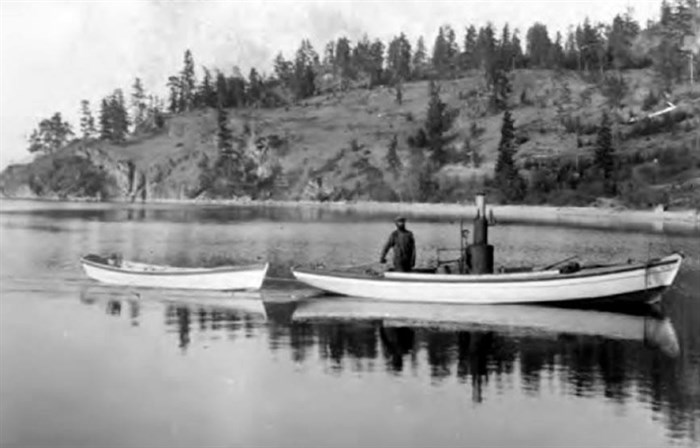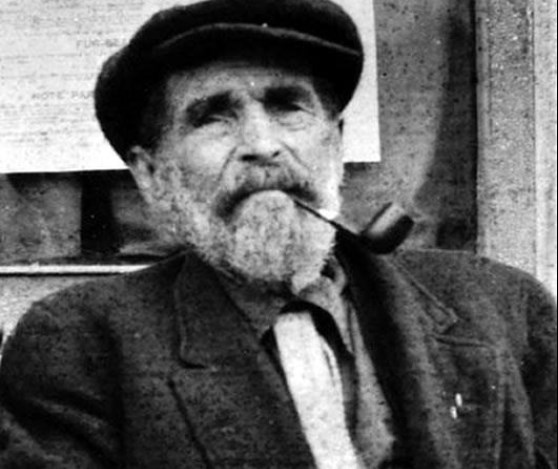
Captain Thomas Shorts in one of his freight hauling boats on Okanagan Lake.
Image Credit: FACEBOOK/Old Kelowna
September 20, 2022 - 7:00 PM
On a good day it will only take a couple of hours to drive the 113-km-length (by road) of Okanagan Lake from Vernon to Penticton.
But there was a time when the same trip could take up to three weeks and require numerous sleep-overs on the lakeshore.
Thomas Shorts, for whom Shorts Creek was named, came to the Okanagan in 1882 after operating a sawmill and a fish market in California and mining in northern B.C., according to the book 'British Columbia-Yukon Sternwheel Days’ by Art Downs.
Shorts quickly saw the need for freight hauling as the Shuswap and Okanagan Railway brought materials to Okanagan Landing, near Vernon, and there were no roads connecting the ends of the lake.
Shorts Creek is on the west side of the lake, near Fintry, and Shorts was one of the pioneers who sold his land to James Dun-Waters who created the Fintry Estates.
READ MORE: iN PHOTOS: The founder of Fintry was no remittance man, he just looked like one at times
The origin of the first freight hauling boat, the ‘Ruth Shorts’ (after his mother), is a bit unclear.
Sharron Simpson, in her historical book ‘The Kelowna Story,’ says he whipsawed the lumber to build the 22-foot rowboat.
A recent post on the Old Kelowna Facebook page, on the other hand, says it was built by a boat builder in Spallumcheen.
Regardless of its origin, the ‘Ruth Shorts’ was the first commercial “freighter” on Okanagan Lake, being launched in 1883.
It was a somewhat erratic service.
“Shorts didn’t like to be tied down so he departed when he felt like it, or when there was enough business to warrant the effort,” Simpson wrote. “He rowed during the day and would pull up to a beach at dusk, where he and his passengers would sleep under the trees for the night.”
If he rowed a straight line, Shorts could make the 105-km-trip in nine days. But, given the need to criss-cross the lake to deliver freight and the vagaries of weather, “it took as long as it took.”
Some trips would take as much as three weeks.
“If a passenger asked how long a trip would take the answer was: ‘Haven’t got the faintest idea, but rest assured we’ll fetch up there sometime,’” Downs wrote. “When a storm blew up, Shorts immediately headed for shore, commenting: ‘Shorts wasn’t born to be drowned.’”

Captain Thomas Shorts.
Image Credit: FACEBOOK/Old Kelowna
While he was the man who pioneered freight hauling on Okanagan Lake, his career was relatively short, in part due to his unwillingness to stick to any kind of schedule.
“For three years, in good weather or bad, the 'Ruth Shorts' delivered bacon, flour, potatoes, coal oil, and candles, and likely the mail to area settlers,” the Old Kelowna post says.
In 1886 Shorts expanded to a 32-foot steamboat – the first steamship on Okanagan Lake. It was called the ‘Mary Victoria Greenhow’ after his partner’s daughter.
It carried five tons of freight – twice as much as the ‘Ruth Shorts’ – along with several passengers.
It was fueled by kerosene. Shorts is reputed to have miscalculated what was needed for the trip so, when he couldn’t borrow more he was forced to row.
“His arrival in Penticton was celebrated with a 21-shotgun salute – no cannons were available,” Simpson wrote. “After acknowledging the tribute, Shorts refuelled and headed back north.”
In 1887, Shorts converted to a wood-burning steam engine in the 35-foot 'Jubilee,' named in honour of Queen Victoria’s 50 years of rule.
That necessitated stacks of wood being strategically placed along Okanagan Lake to keep the boilers running.
“Even those reserves were often not enough and Shorts continued to run out of fuel regularly,” Simpson wrote. “On one trip he was forced to feed his cargo of cedar shakes into the boiler so he could reach his destination.”
When the winter of 1889 freeze ended, the Jubilee sunk to the bottom of the lake. Shorts salvaged the engine, attached it to a scow that he called the ‘City of Vernon’ so he could keep working while a new boat, the ‘Penticton,’ was built.
“Though it was intended to carry passengers as well as freight, Shorts still wasn’t into luxury,” Simpson wrote. “The 'Penticton’s' cabin could hold 25 people but it contained only one chair – first come, first seated.”
Leon Lequime bought the Penticton from Shorts and his partner Tom Ellis in 1892 but after a few years, fell victim to the luxury and power of the Canadian Pacific Railway’s ‘SS Aberdeen,’ the first sternwheeler on the lake.
“Captain T.D. Shorts, ‘a very likeable man, always genial and friendly,’” Downs wrote. “Nothing bothered him.”
Shorts was reputed to have made $6,000 hauling freight in the ‘Ruth Shorts’ but he lost it all when he converted to steam.
“He summed up his loss in a typically forthright manner,” Downs wrote. “’Boys, if we only had as good foresight as we have hindsight, we would raise hell, wouldn’t we.’”
Shorts headed off to the Klondike Gold Rush and died in Hope in 1921 at the age of 84, according to Downs.
To contact a reporter for this story, email Rob Munro or call 250-808-0143 or email the editor. You can also submit photos, videos or news tips to the newsroom and be entered to win a monthly prize draw.
We welcome your comments and opinions on our stories but play nice. We won't censor or delete comments unless they contain off-topic statements or links, unnecessary vulgarity, false facts, spam or obviously fake profiles. If you have any concerns about what you see in comments, email the editor in the link above.
News from © iNFOnews, 2022